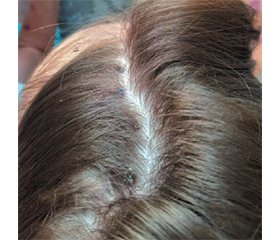Журнал «Здоровье ребенка» Том 19, №1, 2024
Вернуться к номеру
Випадок поєднаної інфекції педикульозу та вітряної віспи в дитини: питання раціонального менеджменту
Авторы: O.V. Shvaratska, V.V. Mavrutenkov, T.V. Svyatenko, O.M. Yakunina
Dnipro State Medical University, Dnipro, Ukraine
Рубрики: Педиатрия/Неонатология
Разделы: Справочник специалиста
Версия для печати
Педикульоз та вітряна віспа, поширені в дітей, зазвичай не становлять значних проблем для діагностики та лікування. Однак повномасштабна війна, що триває в Україні, призвела до серйозних гуманітарних наслідків, включно з масовою міграцією та пошкодженням інфраструктури системи охорони здоров’я. За таких умов стандартні методи лікування, зокрема ізоляція та гігієнічні заходи, можуть бути нездійсненими. Ці виклики підкреслюють необхідність адаптації стратегій ведення пацієнтів до кризових умов. Наведено випадок поєднаної інфекції головного педикульозу та вітряної віспи, ускладненої фолікулітом, у раніше здорової дитини 10 років. Педикульоз виявлено батьками за тиждень до захворювання на вітряну віспу, вони самостійно одноразово застосували місцевий антипедикульозний засіб на основі клеаролу і диметикону. На 12-й день захворювання на вітряну віспу ми помітили гнійні елементи висипу на волосистій частині голови, сильний свербіж, наявність яєць вошей та гнид. З огляду на фолікуліт, що ускладнював застосування топічних педикуліцидів та гігієнічних процедур, випадок потребував індивідуального підходу до терапії. Останній включав цефуроксим перорально для лікування бактеріальної суперінфекції та дві дози івермектину перорально для лікування педикульозу — по 200 мкг/кг з інтервалом у тиждень, а також хлоропіраміну гідрохлорид для зменшення свербежу. Стратегія привела до ліквідації педикульозу без розвитку побічних ефектів. Цей випадок ілюструє гостру потребу в оновленні клінічних протоколів та навчанні медичних працівників оптимальним методам лікування, особливо в кризових умовах. Поєднання вітряної віспи та педикульозу призвело до розвитку бактеріальної суперінфекції, що потребувала системної антибіотикотерапії. Клінічні дослідження підтверджують ефективність перорального івермектину для лікування педикульозу у випадках, коли місцеві педикуліциди не можуть бути використані. Для запобігання ускладненням вітряної віспи та контролю епідемічних процесів рекомендується інтегрувати вакцинацію проти вітряної віспи до національного календаря щеплень. Крім того, у випадках поєднання вітряної віспи та ектопаразитарних інфекцій слід розглянути можливість системного лікування противірусними та протипаразитарними препаратами, такими як ацикловір та івермектин, для мінімізації ризику суперінфекції. Ми вважаємо доцільною державну реєстрацію перорального івермектину для лікування педикульозу, щоб формалізувати його використання в клінічній практиці.
Pediculosis and varicella, common in children, typically pose no significant diagnostic or treatment challenges. However, the ongoing full-scale war in Ukraine has led to severe humanitarian consequences, including mass migration and health care infrastructure damage. Under such conditions, standard treatment modalities, including isolation and hygiene measures, may be impracticable. These challenges underscore the need for adapting patient management strategies to crisis conditions. We report a case of a previously well 10-year-old female, presenting with pediculosis capitis and varicella co-infection, complicated by folliculitis. Pediculosis had been detected by the parents one week before the onset of varicella, and they self-administered a topical anti-pediculosis agent based on clearol and dimethicone once. On the 12th day of varicella infection, we found purulent rash elements on the scalp, severe pruritus, and presence of lice eggs and nits. Considering the evidence of folliculitis on the scalp, which complicated the use of external pediculicides and hygienic procedures, the case necessitated a tailored treatment approach. This included oral cefuroxime for bacterial superinfection, and two doses of oral ivermectin for pediculosis 200 mcg/kg one week apart, along with chloropyramine hydrochloride for pruritus management. The strategy resulted in elimination of head lice infestation with no adverse events. This case illustrates the critical need for updated clinical protocols and health care provider education on optimal treatment practices, especially in crisis contexts. The coexistence of varicella with a pediculosis infection precipitated a secondary bacterial infection requiring systemic antibacterial treatment. Clinical research provides evidence of oral ivermectin effectiveness in pediculosis treatment when topical pediculicides cannot be utilized. To mitigate varicella complications and control epidemic processes, integrating varicella vaccination into the national immunization schedule is recommended. Moreover, for cases with varicella and ectoparasitic infections, systemic treatment with antiviral and antiparasitic agents like acyclovir and ivermectin should be considered to minimize the risk of superinfection. The registration of oral ivermectin for pediculosis treatment by state health authorities is advocated to formalize its use in clinical practice.
вітряна віспа; педикульоз; лікування; ацикловір; івермектин; діти
varicella; pediculosis, treatment; acyclovir; ivermectin; children

